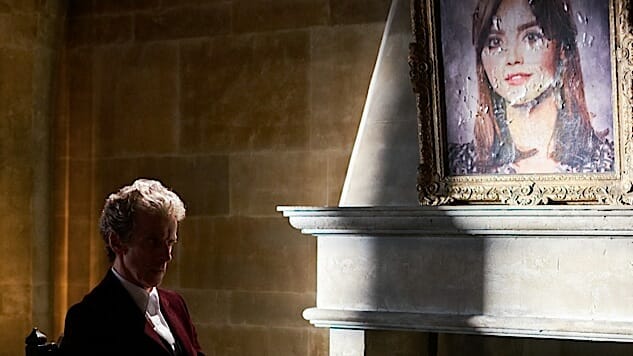Doctor Who: “Heaven Sent”
(Episode 9.11)

I’m nothing without an audience.—The Doctor
How does one begin to approach a character that has become so emblematic, that they effectively become bigger than any writer, director or actor that dares tackle them? The Daniel Craig-era James Bond films took the character back to his origins. Christopher Nolan stripped the Batman films of their stylized funny business and embraced a gritty, grounded aesthetic. Most recently, Creed brilliantly progressed the Rocky franchise by having Sylvester Stallone’s Italian Stallion play mentor to a young upstart.
Ultimately, what’s fascinating about these examples is that they end up saying more about the creatives behind-the-scenes than they do about the actual central characters. Since taking the reins of the show back in 2010, Steven Moffat—a self-professed classic Doctor Who fanatic—has spent his tenure exploring the ins and outs of his beloved childhood icon. Such an introspective approach primarily centers on the moral implications of what it means to be The Doctor, a being that has lived for thousands of years and spends his days playing God to the universe. In this way, “Heaven Sent” stands as the quintessential Steven Moffat story in that it removes the familiar, formula trappings (i.e. fighting a monster) resulting in a barebones meditation on The Doctor and his fears. In the process, it posits several questions: what is The Doctor like when he has no audience for which to perform? Once dubbed by Davros as someone who keeps running and never looks back, “because he dare not out of shame,” what does he do when there’s nowhere left to run (or, in his own words, “I’ve finally run out of corridor—there’s a life summed up”)?
The episode is presented as, essentially, a one-man show, with the only other major characters being a mute, mysterious monster and the (mostly) unseen ghost of Clara Oswald. Right off the bat, Moffat deserves credit for executing a Who story that—after more than 30 seasons and close to 1,000 episodes—has never been executed before.
So how do things shake out? Short answer: “Heaven Sent” is a masterpiece of the highest order. Long answer? Well, read along…
Taking off directly from the events of “Face the Raven” (or so we think), we find The Doctor quickly deducing that he has been transported to some kind of prison—and he’s not alone. TV monitors across the area reveal the POV of something moving slowly towards him. His pursuer turns out to be a tall, frightening creature shrouded in a veil. Recognizing this as a nightmarish image from his youth made tangible, The Doctor determines that this environment is designed to frighten him for some strategic purpose.
As The Doctor explores the area and evades the veiled monster, he discovers several peculiar clues—a single skull near the transporter, the word “BIRD” spelled out in sand, a seemingly fresh collection of his clothes drying near a fireplace, a sky full of stars in the wrong spot, etc. Most notable, after jumping out of a window to avoid the creature’s deathly grasp, he falls into the water below and discovers mountains of human skulls littering the seabed. Obviously, The Doctor is not the first person to be trapped here. Taking cues from both Hammer horror films and the layout of Hogwarts, the “prison” resembles an abandoned Game of Thrones set and goes about reconfiguring itself several times throughout the episode after The Doctor makes a “confession” to the monster, who also mysteriously freezes whenever he does so (The Doctor’s first confessions—despite always laughing in the face of death, he is, indeed, afraid to die). Eventually, he unearths a clue that points him to a possible escape route in “Room 12.”
Now, the innate challenge of structuring an episode featuring a single character should be fairly obvious—how do you make it not boring? Do you write little-to-no dialogue and pray the visuals can illustrate the character’s unspoken experiences? Do you risk contrivance by having the character frequently talking to himself? Luckily, the Who creative team have an effective out—The Doctor always talks to himself. After all, between companions, he can spend centuries traveling alone. As evidenced by last season’s “Listen,” this means a lot of monologuing. Fortunately, the Who crew also do not overindulge this technique, as they are sensible enough to realize that Peter Capaldi can convey pages worth of dialogue with a few choice looks.
When he’s not babbling out loud to himself, The Doctor problem solves by imagining himself back in the TARDIS, bouncing questions off a mute Clara—her back perpetually turned to the camera—who communicates via chalkboard writing (again, a nice callback to “Listen”). These scenes become particularly noteworthy in moments of high-danger, where we see The Doctor’s frantic thought process articulated via an “exchange” with his deceased companion. This juxtaposition between reality and the machinations occurring inside the main character’s head is probably the closest Who has ever come to replicating Moffat’s other beloved show, Sherlock.
-

-

-

-

-

-

-

-

-

-

-

-

-

-

-

-

-

-

-

-

-

-

-

-

-

-

-

-

-

-

-

-

-

-

-

-

-

-

-

-








































